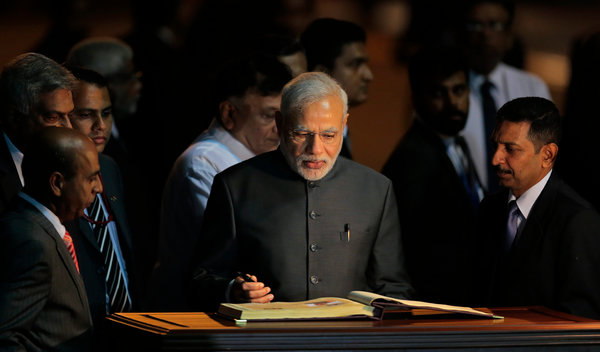
Prime Minister Narendra Modi of India in Colombo, Sri Lanka.CreditEranga Jayawardena/Associated Pr
COLOMBO, Sri Lanka — Prime Minister Narendra Modi ofIndia brought his rock-star appeal to this island nation Saturday in a visit that has charmed this once deeply divided society.
He became the first Indian prime minister to visit Jaffna, a city in this nation’s northern province that is still struggling to recover from decades of war between Tamil rebels and the central government. Mr. Modi, whose own country is home to millions of Tamils, has made a strong appeal for empowerment of Sri Lanka’s Tamil minority.
“We stand with you in your efforts to build a future that accommodates the aspiration of all sections of society, including the Sri Lankan Tamil community for a life of equality, justice and dignity in a united Sri Lanka,” Mr. Modi said in a speech a day earlier.
Mr. Modi’s visit generated banner headlines in Sri Lankan newspapers and fawning coverage on TV. His is the first bilateral visit by an Indian prime minister to this country in 28 years.
The visit “reflects the enhanced engagement with South Asia as part of the ‘Neighborhood First’ policy articulated by Prime Minister Modi on his first day in office,” said Syed Akbaruddin, spokesman for the Indian Ministry of External Affairs. Mr. Modi’s trip included earlier stops in The Seychelles and Mauritius.
Mr. Modi was elected last year on a platform of development and improved governance, but his greatest successes so far have come in foreign policy, where he has reversed decades of India’s lack of attention to its southern and eastern neighbors.
Last year, he became the first Indian prime minister in 17 years to make a state visit to Nepal, which is tied to India economically and politically. Mr. Modi’s decision to pay attention to Nepal transformed the relationship.
Sri Lanka had been gradually drifting out of India’s orbit, with the previous government favoring China over India and awarding Chinese companies lucrative contracts to build roads and ports. India grew particularly alarmed when this country hosted Chinese military submarines.
But Maithripala Sirisena’s surprise election as president in January and his appointment of Prime Minister Ranil Wickremesinghe, seen as pro-Indian and pro-western, has allowed the two countries to reset relations.
“The importance of this visit is in the coincidence and congruence of strategic interests between these two new governments,” Paikiasothy Saravanamuttu, executive director of the Center for Policy Alternatives here, said in an interview.
During his visit to Jaffna on Saturday, Mr. Modi commissioned a section of railway track built with Indian assistance. Jaffna is the cultural heart of this country’s Tamil minority and was badly damaged during the civil war,which ended in 2009 when the Sri Lankan government defeated the Liberation Tigers of Tamil Eelam.
India played a troubled role during the war when its military was deployed in a peacekeeping mission and Indian troops got involved in fights that cost the lives of 1,000 Indians and led a Tiger sympathizer to assassinate Rajiv Gandhi, a former Indian prime minister, in 1992.
Mr. Gandhi was the last prime minister to visit Sri Lanka, in 1987, but the trip was marred when a Sri Lankan sailor hit Mr. Gandhi with his rifle butt during a guard of honor inspection.
India has a deep interest in this country’s efforts to reconcile with its Tamil minority not only because southern India is home to 60 million Tamils but also because it accepted 100,000 Sri Lankan refugees during the civil war whom India is now encouraging to return home.
Mr. Sirisena’s government has promised a series of efforts to improve relations with Tamils, including releasing political detainees and releasing land seized from Tamil families without compensation during the civil war.